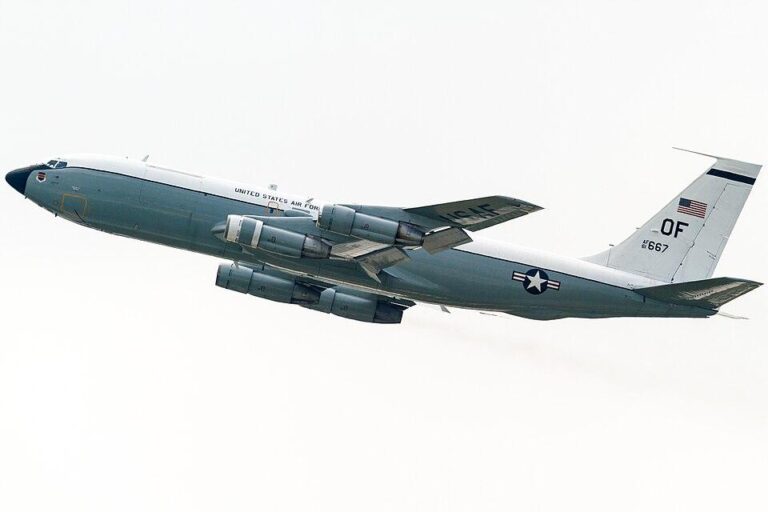Amid escalating tensions between Iran and Israel, the United States has deployed a specialized nuclear detection aircraft to the region, raising international attention. The move comes in response to growing concerns over potential nuclear activities and to enhance surveillance capabilities amid the volatile conflict. Here’s what we know so far about the US nuclear sniffer plane deployment and its implications for regional security.
US Deploys Nuclear Sniffer Plane Amid Rising Iran Israel Tensions
Amid escalating tensions between Iran and Israel, the United States has deployed a specialized surveillance aircraft equipped with advanced nuclear detection technology. This move comes as a precautionary measure to monitor any potential nuclear activity or threats in the volatile region, underscoring Washington’s commitment to intelligence gathering and regional stability. The aircraft, known informally as a “nuclear sniffer,” is capable of detecting radiation signatures from nuclear materials, providing real-time data to US and allied command centers.
Key aspects of this deployment include:
- Surveillance Capabilities: The plane’s sensors can detect airborne nuclear particles, which helps track any unauthorized nuclear tests or weapon movements.
- Operational Range: It can operate across the Middle East, covering sensitive areas where nuclear development concerns are highest.
- Intelligence Integration: Data collected feeds directly into US intelligence networks, aiding policymakers in crisis assessment.
| Feature | Details |
|---|---|
| Aircraft Model | WC-135 Constant Phoenix |
| Mission Type | Nuclear Radiation Detection |
| Deployment Area | Middle East |
| Detection Range | Thousands of square miles |
Capabilities and Mission Focus of the US Nuclear Detection Aircraft
The US nuclear detection aircraft, often referred to as the “nuclear sniffer”, is engineered with highly sensitive sensors designed to detect and analyze airborne radioactive particles. Its primary function lies in tracking nuclear activities from a safe distance, providing real-time intelligence on potential nuclear detonations, emissions, or accidents. Equipped with an array of spectrometers and radiation detection systems, these planes can differentiate between natural background radiation and signals indicating man-made nuclear material.
Key capabilities include:
- Detection of various radioactive isotopes with pinpoint accuracy
- Rapid area surveillance for nuclear events or threats
- Real-time data transmission to ground command centers
- Operation in diverse weather and geographic conditions
- Support in verifying compliance with international nuclear treaties
This mission focus aims to strengthen early warning systems globally, especially in volatile regions where nuclear tensions rise. As geopolitical issues intensify, such airborne platforms become invaluable assets for diplomatic channels and military strategists alike, safeguarding against inadvertent or intentional nuclear incidents.
| Feature | Description |
|---|---|
| Detection Range | Up to 300 kilometers radius |
| Aircraft Model | Modified WC-135 Constant Phoenix |
| Sensor Type | Gamma and neutron spectrometry |
| Data Link | Secure satellite communications |
| Operational Altitude | 20,000 – 40,000 feet |
Implications for Regional Security and International Diplomatic Efforts
The deployment of a U.S. nuclear sniffer plane signals a heightened level of vigilance in a region already fraught with tensions. This move acts as both a deterrent and a reassurance, showcasing the U.S.’s commitment to preventing any potential nuclear escalation between Iran and Israel. Regional actors are now under intense scrutiny, complicating the strategic calculations for all stakeholders involved. Key implications include:
- Increased military readiness: Neighboring states may boost their defensive postures in anticipation of potential fallout.
- Diplomatic tension rise: The presence of surveillance assets could be perceived as provocative, straining U.S.-Iran relations further.
- Intelligence sharing: Enhanced collaboration between U.S. allies to monitor and mitigate risks stemming from nuclear proliferation.
On the diplomatic front, this deployment underscores the complex balancing act facing international mediators who strive to de-escalate hostilities without compromising sovereign security concerns. Efforts by global powers to initiate talks or impose sanctions now carry additional weight, as any misstep could inadvertently catalyze a dangerous escalation. Coordination remains critical, with three key priorities emerging for diplomatic channels:
| Diplomatic Priorities | Objectives |
|---|---|
| Dialogue Facilitation | Encourage direct talks between Iran and Israel to reduce misunderstandings |
| Sanctions Management | Implement targeted sanctions without escalating civilian suffering |
| Multilateral Engagement | Support UN and regional bodies’ role in conflict resolution |
Recommendations for Monitoring and De-escalation in a Volatile Environment
In an environment charged with geopolitical tensions, continuous monitoring is indispensable to preempt escalation. Authorities must deploy advanced surveillance systems, such as airborne sensors and satellite imaging, to detect and analyze sudden military activities or movements. Real-time data sharing among allied nations and intelligence agencies is crucial to maintain situational awareness. This approach allows for early identification of potential threats, enabling timely diplomatic interventions before confrontations intensify.
Equally important is the implementation of clear de-escalation protocols rooted in dialogue and restraint. Diplomatic channels should remain open even amidst hostility, facilitating communication to clarify intentions and reduce misunderstandings. Confidence-building measures such as mutual ceasefire agreements or third-party mediation can serve to cool tempers on both sides. Below is a simplified overview of recommended actions:
- Establish Hotlines: Direct communication lines between military leaders.
- Third-party Monitoring: Neutral observers to verify compliance on the ground.
- Incremental Confidence-building: Stepwise relaxation of force postures.
The Way Forward
As tensions continue to escalate in the volatile region, the deployment of the US nuclear sniffer plane underscores Washington’s vigilance and strategic monitoring efforts amid the Iran-Israel conflict. While details remain limited, this move reflects broader international concerns over nuclear proliferation and regional security. Observers will be closely watching developments in the coming days, as diplomatic and military activities unfold against a backdrop of deepening uncertainty. For now, the presence of the reconnaissance aircraft serves as a stark reminder of the high stakes involved and the complexities of maintaining stability in the Middle East.







